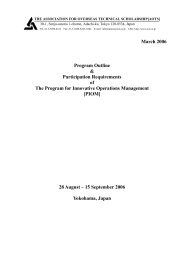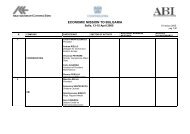Analysis of the Operation and Financial Condition of the Enterprise
Analysis of the Operation and Financial Condition of the Enterprise
Analysis of the Operation and Financial Condition of the Enterprise
You also want an ePaper? Increase the reach of your titles
YUMPU automatically turns print PDFs into web optimized ePapers that Google loves.
<strong>Analysis</strong> <strong>of</strong> <strong>the</strong> <strong>Operation</strong> <strong>and</strong> <strong>Financial</strong> <strong>Condition</strong> <strong>of</strong> <strong>the</strong> <strong>Enterprise</strong> Generally accepted parameters; Industry average figures; Analogue indicators from previous periods; Indicators from competitor enterprises; Any o<strong>the</strong>r indicators form analysis estimates.There are advantages <strong>and</strong> disadvantages in using every base <strong>of</strong> comparison: Only for a few ratios any st<strong>and</strong>ards or generally accepted measures exist;Besides, <strong>the</strong> variance <strong>of</strong> <strong>the</strong> enterprise indicators from generally accepted st<strong>and</strong>ards can beassociated with <strong>the</strong> specifics <strong>of</strong> <strong>the</strong> industry, <strong>the</strong> specifics <strong>of</strong> development <strong>of</strong> businessenvironment or its seasonal character; Often it is not possible to obtain fair information about <strong>the</strong> industry averageindicators; It is only possible to obtain data about some average data <strong>of</strong> enterprises that canserve as benchmark data; Comparison <strong>of</strong> <strong>the</strong> enterprise ratios with <strong>the</strong> own indicators only allows toidentify <strong>the</strong> area <strong>of</strong> development <strong>of</strong> <strong>the</strong> enterprise itself <strong>and</strong> doesn’t provide any informationabout <strong>the</strong> ranking <strong>of</strong> <strong>the</strong> enterprise within <strong>the</strong> industry <strong>and</strong> to compare to its competitors; Only published data can be obtained about <strong>the</strong> competitor enterprise that maynot be detailed enough in order to form <strong>the</strong> basis for comparison <strong>of</strong> indicators; The indicators <strong>of</strong> any o<strong>the</strong>r enterprise analysed include specific enterprise dataaffecting also <strong>the</strong>se indicators.Three different techniques exist for <strong>the</strong> comparison <strong>of</strong> financial indicators: comparison with <strong>the</strong> ideal level (rule-<strong>of</strong>-thumb measures); comparison to previous periods; comparison to <strong>the</strong> industry level.Comparison with a benchmark – <strong>the</strong> calculated indicators (ratios) are comparedto <strong>the</strong> ideal (desirable) level <strong>of</strong> <strong>the</strong>se indicators. For example, it is recognised that <strong>the</strong>acceptable level <strong>of</strong> <strong>the</strong> quick ratio could be from 1 to 2, similar benchmarks have beenrecommended also for o<strong>the</strong>r ratios. This technique, however, should not be idealised, as<strong>the</strong>re are no two absolutely identical enterprises <strong>and</strong> each enterprise has its own specificswhich needs to be taken into account when doing evaluation <strong>of</strong> financial data. So, forexample, a high quick ratio can be <strong>the</strong> result <strong>of</strong> unfavourable crediting policy(insubstantially high amounts <strong>of</strong> customer debts), too old or obsolete stock etc. In ano<strong>the</strong>renterprise this liquidity indicator could be considerably lower however if such a situation is<strong>the</strong> result <strong>of</strong> a rational credit policy, <strong>the</strong> liquidity ratio <strong>of</strong> an enterprise may as well be high.Therefore, when using <strong>the</strong> technique <strong>of</strong> comparison, it has to be done carefully.Comparison with <strong>the</strong> previous periods gives <strong>the</strong> opportunity to conclude whe<strong>the</strong>r<strong>the</strong> indicators have improved or declined. Such comparison can likewise be useful whenforecasting <strong>the</strong> enterprise development trends. As <strong>the</strong> rate <strong>of</strong> development can vary in <strong>the</strong>course <strong>of</strong> time, forecasting should be done prudently. One <strong>of</strong> <strong>the</strong> drawbacks <strong>of</strong> thistechnique is also <strong>the</strong> fact that not always <strong>the</strong> level <strong>of</strong> <strong>the</strong> previous periods is easilycomparable. For example, return on equity has increased in <strong>the</strong> enterprise over one yearfrom 4% to 6%; this cannot be admitted to be a big achievement as even <strong>the</strong> 6% return isnot sufficiently high.45
















